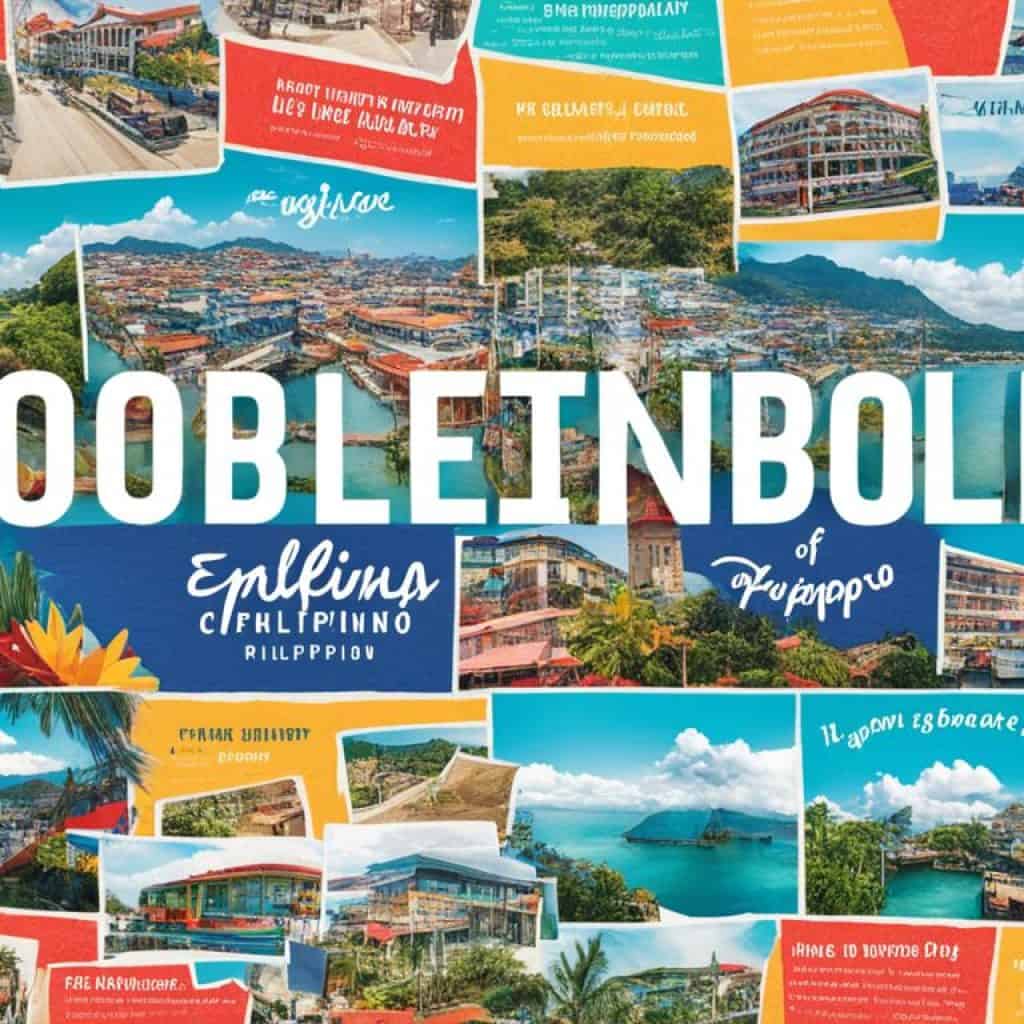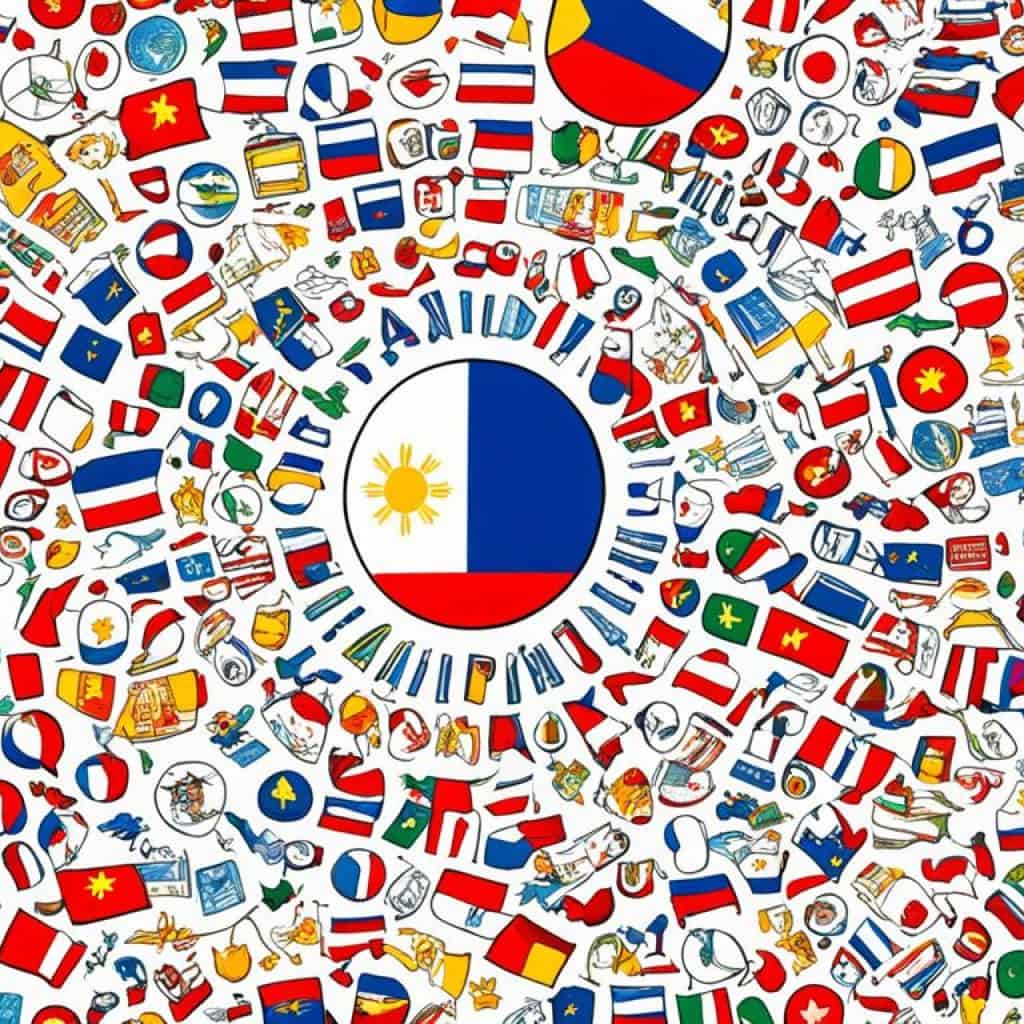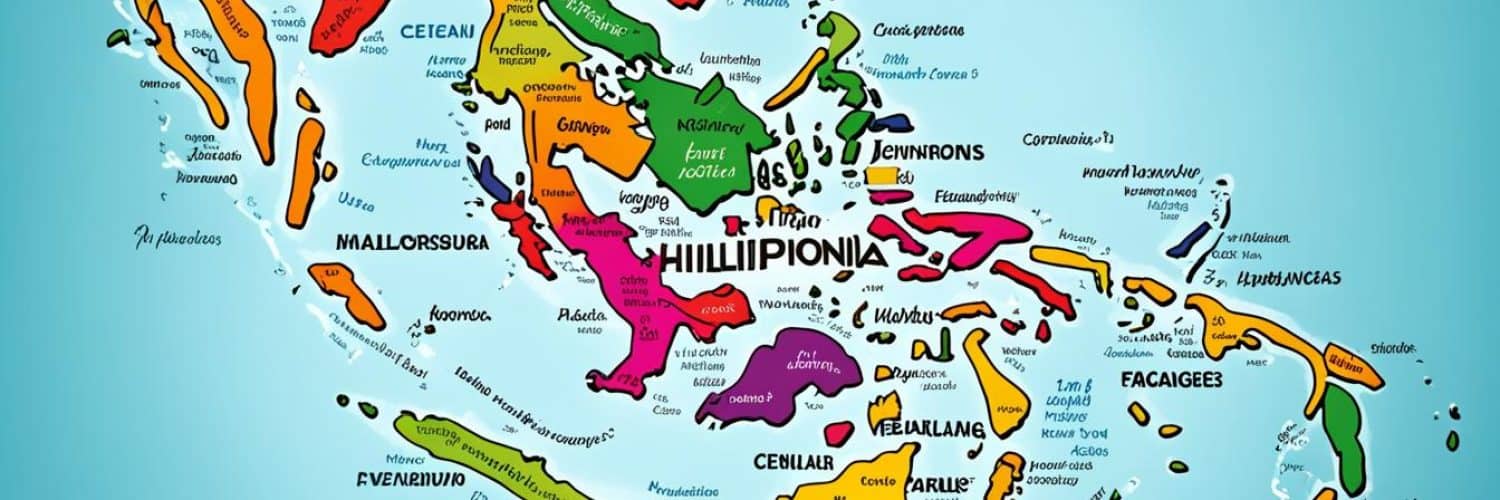Have you ever thought about the languages spoken in the Philippines? Is there one language that stands out as the official one? And how many languages do people actually speak there?
Let’s explore the rich variety of languages in the Philippines. We’ll find out the intriguing answers to these questions.
Key Takeaways:
- The Philippines is home to about 130 to 195 languages, showing its vast linguistic diversity.
- Filipino and English are the official languages. They are very important in government, schools, and the media.
- The most spoken native language is Tagalog, also known as Filipino. Other popular languages include Cebuano, Ilocano, and Hiligaynon.
- Spanish words mixed into Filipino during the colonial period. This also led to creole languages like Chavacano, influenced by Spanish.
- Many people in the Philippines speak English well. This skill helps in getting jobs, especially in the outsourcing business.
Official Languages of the Philippines
The Philippines has two official languages: Filipino and English. Filipino, based on Tagalog, is the national language. It’s regulated by the Commission on the Filipino Language. Meanwhile, English is used in government, education, and media.
Filipino helps people from different linguistic backgrounds communicate. It brings unity and understanding to the Filipino people. English, on the other hand, is used in official matters. It helps the Philippines connect with the world and opens global doors.
In schools, students learn both Filipino and English. Filipino is often the main language used in classes. This approach makes sure students can communicate well in both languages. It helps them engage in various parts of society.
Most Spoken Native Languages in the Philippines
The Philippines is known for its many languages. Each language shows the rich culture of its region. Let’s look at the most spoken native languages there.
Tagalog Language
Tagalog, or Filipino, is the top native language in the Philippines. It is mainly spoken in central Luzon and some parts of Mindanao. As an Austronesian language, it shares traits with Visayan languages.
Cebuano Language
Cebuano is also key in the Philippines, especially down south. It’s the main language in Cebu, Bohol, and other areas in Visayas and Mindanao. This language stands out for its unique words and grammar.
Ilocano Language
In northern Luzon, particularly in Ilocos Region, many speak Ilocano. It’s an Austronesian language too, part of the West Philippine subgroup. Ilocano is famed for its literature, influencing the area’s culture.
Hiligaynon Language
Hiligaynon, or Ilonggo, is popular in Western Visayas. This includes Iloilo, Negros Occidental, and Guimaras. Another Austronesian language, it adds to the region’s cultural diversity through its literature and music.
These languages, among others, help shape Filipino society. They add to the Philippines’ cultural diversity and regional pride. Together, they create a rich linguistic mosaic for the country.
| Native Language | Region | Number of Native Speakers |
|---|---|---|
| Tagalog | Central Luzon, parts of Mindanao | Approximately 24 million |
| Cebuano | Visayas, parts of Mindanao | Approximately 21 million |
| Ilocano | Northern Luzon | Approximately 8 million |
| Hiligaynon | Western Visayas | Approximately 7 million |
Spanish Influence and Spanish Creole Languages
The Spanish language greatly influenced the Philippines during Spanish colonial times. It left a mark on the culture and the way people talk. Though not many speak Spanish there now, its effects are still seen today.
Only 0.5 percent of people in the Philippines speak Spanish today. But this small number shows Spanish still impacts the country’s languages. It shows how diverse the Philippines is.
Spanish words are also part of the Filipino language. About 4,000 Filipino words come from Spanish. These words are used every day, making the language rich.
“The Spanish language has left an indelible mark on the Philippines, shaping not only our vocabulary but also our cultural heritage.”
There are also languages called Chavacano that are influenced by Spanish. They are spoken in places like Zamboanga City. Chavacano is a mix of Spanish and local languages. It is unique and shows Spanish influence in the Philippines.
English Language in the Philippines
The English language has been crucial in the Philippines since the American occupation in the early 20th century. It is widely used in government, education, and business. A majority of Filipinos have some level of English skills.
English proficiency has opened international doors for Filipinos. It helps in finding jobs, studying, and traveling abroad. The outsourcing industry benefits from this, attracting global businesses that need English-speaking staff.
“English proficiency in the Philippines has paved the way for the country to become a global player in the outsourcing industry. Many multinational companies choose the Philippines as their preferred destination due to the highly skilled English-speaking workforce.”
English also boosts the country’s economy. It’s a bridge language in business, easing local and global company collaboration. This increases trade and investment, fueling economic growth.
In schools and universities, English is key. It’s both a subject and a medium of instruction across various fields. This prepares students for local and international careers or higher education.
The Importance of English Proficiency
Being proficient in English gives Filipinos a global edge. It allows connections with different cultures, enhancing cross-cultural ties and teamwork.
The government and schools emphasize English learning. They recognize its role in national development. There’s a push to improve English programs to aid students in a modern world.
Challenges and Opportunities
Despite widespread English proficiency, quality educational access varies. Efforts are ongoing to close this gap, ensuring all Filipinos can advance their language skills.
There’s a move towards multilingualism and valuing indigenous languages. This is alongside promoting English and Filipino. Balancing English proficiency with preserving local languages is a government goal.

English is now a pillar of Philippine society, benefiting individuals and the country. It enables global participation, international opportunity access, and aids economic development.
Indigenous and Regional Languages
The Philippines has many native and regional languages, showcasing its rich cultural mix. These languages reflect the diverse culture of various ethnic groups.
Languages like Ibanag, Ivatan, and Kapampangan are spoken in specific areas. They often have an official status in their places, as per the constitution.
These local languages add to the Philippines’ cultural richness. They keep unique cultural identities alive and make their speakers proud.
They are more than just ways to talk. These languages hold cultural wisdom, passed down from one generation to the next.
Keeping these languages alive is crucial. It helps keep the Philippines’ cultural diversity intact and honors its rich heritage.
Decreasing Use of Indigenous Scripts
The Philippines is home to unique indigenous scripts like Baybayin and Tagbanwa. But, their use has dropped significantly in recent times. The decline is mostly because of Spanish and American colonial influence. This led to the adoption of the Latin script for Philippine languages.
Baybayin, a notable indigenous script, is still recognized today. It appears in art and Philippine banknotes, showing its cultural importance. In the southern Philippines, the Arabic script is used by Muslims.
Even though they’re used less, these scripts are very important. They show the rich culture and language diversity of the Philippines.
Below, you can see an example of the Baybayin script:
Language Policies and Legislation
The Philippines has rules and laws for its many languages. These are based on the constitution and laws to help manage and encourage different languages.
The Commission on the Filipino Language oversees these language policies. Its job is to regulate and promote Filipino as the nation’s language. Filipino, a form of Tagalog, helps people from different language groups communicate.
Not only does Filipino matter, but regional languages are also vital. They get official status in their areas. Although not named specifically, this helps keep and encourage the country’s language variety.
Commission on the Filipino Language
The Commission on the Filipino Language is a key agency. It focuses on the Filipino language’s growth and use in areas like education and government.
The Commission on the Filipino Language plays a crucial role in shaping language policies and promoting language rights in the Philippines. Through its efforts, it aims to preserve the cultural heritage embedded within the language and foster a sense of national unity and identity.
Preserving Linguistic Diversity
Preserving language variety is a big focus in the Philippines. The government sees the nation’s languages as part of its culture and history. They work to keep and support these languages for the future.
These policies show the Philippines’ dedication to cultural variety and identity. They do this by promoting Filipino as the national language.
| Linguistic Diversity | Language Policies |
|---|---|
| The Philippines has a rich linguistic diversity with numerous languages spoken throughout the country. | The government recognizes the importance of preserving linguistic diversity and has implemented language policies to protect and promote regional languages. |
| Language diversity reflects the cultural heritage of different ethnic groups in the Philippines. | The Commission on the Filipino Language regulates and promotes Filipino as the national language, while also recognizing the official auxiliary status of regional languages. |
| Preserving linguistic diversity contributes to the country’s cultural richness and heritage. | The aim is to foster a sense of national unity and identity while celebrating the diverse linguistic traditions present in the Philippines. |
Language Education in the Philippines
In the Philippines, teaching languages is very important in schools. Filipino and English are the main focuses. Filipino is mostly used for teaching, while English is a subject and widely used in work and school.
There’s a big push for education in the mother tongue. It values local languages along with Filipino and English. This helps keep the country’s many languages alive.
Learning languages helps students talk well in Filipino and English. The lessons include reading, writing, and speaking. This way, students can take part in society and work well with others.
“Language education in the Philippines plays a crucial role in fostering linguistic competence, cultural awareness, and communication skills among students.”
Teachers are key to great language learning. They use different ways to make lessons interesting. This includes group work and speaking practices.
Technology is also making language learning better in the Philippines. Students now use online tools and apps. This makes it easier to practice on their own.
By learning languages, students understand more cultures. They learn about traditions and people’s ways of life in the Philippines. This builds respect and knowledge.
Benefits of Language Education
Language education in the Philippines offers various benefits:
- Enhanced communication skills in both Filipino and English.
- Improved literacy and comprehension abilities.
- Greater access to educational and professional opportunities.
- Increased cultural appreciation and understanding.
- Stronger sense of national and regional identity.
Good language skills prepare Filipinos for the world. They can talk to others better, understand different views, and help their community and economy grow.

Language and Cultural Identity
Language is key in shaping the Philippines’ cultural identity. Its many languages reflect a rich cultural heritage. People in different language groups often have a deep pride in their languages.
The rivalry between Tagalog and Cebuano speakers shows how closely people identify with their languages. These languages do more than let people talk to each other. They also show a person’s cultural background and heritage.
“Language is the key to the heart of a culture, and it helps us understand and appreciate the unique traditions, customs, and values of different communities within the Philippines.”
The Philippines’ many languages add to its cultural richness. Each language brings unique traditions and customs. This makes the country’s culture richer and more diverse.
This variety of languages is celebrated in festivals, literature, and music. It shows the country’s artistic richness.
Languages also help keep culture alive. They maintain oral traditions and ancestral practices. They ensure that customs, stories, and values are passed on, keeping traditions alive.
The link between language and cultural identity in the Philippines highlights its diversity and richness. It’s important to keep this linguistic diversity. It helps maintain the Philippines’ cultural heritage and brings its people together.
Language and Cultural Identity in Quotes:
“Language is the thread that weaves the tapestry of cultural identity in the Philippines, connecting individuals to their roots and creating a sense of belonging.” – Dr. Maria Santos, Cultural Anthropologist
“The linguistic landscape of the Philippines reflects the colorful diversity of its people, with each language group contributing unique shades to the vibrant cultural mosaic of the country.” – Dr. Juanito Alvarez, Linguist
| Language Group | Cultural Affiliations | Major Regions |
|---|---|---|
| Tagalog | Tagalog-speaking communities | Central Luzon, parts of Mindanao |
| Cebuano | Cebuano-speaking communities | Visayas, Mindanao |
| Ilocano | Ilocano-speaking communities | Ilocos Region, Cordillera Administrative Region |
Language in Daily Life and Communication
In the Philippines, language is very important in everyday life and how we talk to each other. Because there are many languages, people often use more than one to understand each other well.
The national language, Filipino, helps people from different places talk to each other. It’s based on Tagalog and many people across the country speak it.
English is also key in the country, especially in government, schools, and businesses. Many Filipinos are very good at English.
Besides Filipino and English, there are local languages too. For example, Cebuano in Cebu and Ilonggo in Iloilo. These languages are very important to their communities and add to the Philippines’ rich languages.
“Language has always been a bridge that connects us Filipinos, enabling us to forge connections and build relationships across our diverse communities.” – Maria Santos, Linguistics Professor
In the Philippines, people often switch languages smoothly during conversations. They mix Filipino, English, and local languages easily to express themselves.
This shows how adaptable and welcoming Filipinos are. It helps them get past communication barriers and build strong bonds with each other.
The Role of Language in Daily Life
Language is a big part of life in the Philippines. It helps people talk to each other effectively. It also keeps cultural traditions alive and builds community ties.
Language shapes our relationships whether in casual chats, business, or family meet-ups. It makes us feel we belong in our community.
Language as the Key to Cultural Understanding
The Philippines has many languages, which help us appreciate our culture more. By learning different languages, we can understand various traditions and values better.
Language connects people from different areas. It brings empathy and understanding. Through language, we celebrate our diversity and aim to be united as a country.
Unifying a Nation through Language
While the Philippines is linguistically diverse, Filipino and English help unite us. These common languages make communication easier. They help us bridge gaps between different areas and backgrounds.
Sharing a language brings Filipinos together. It helps us understand each other and work for a better country.
Languages in Daily Life in the Philippines
| Language | Usage |
|---|---|
| Filipino | Serves as the lingua franca, enabling communication across linguistic backgrounds |
| English | Used in official capacities such as government, education, and business |
| Regional Languages | Spoken within specific communities, preserving cultural heritage |
In conclusion, language plays a huge role in the Philippines. It helps people from different backgrounds talk to each other. English and local languages enhance our culture. By mixing languages, Filipinos show how flexible they are. Language brings us together, lets us enjoy our diverse cultures, and helps us understand each other better.
Language and Economic Opportunities
English skills have helped Filipinos, especially in the outsourcing field. The Philippines is now a key spot for call center jobs and more, thanks to these skills.
International companies come to the Philippines because people here speak English well. This skill makes Filipinos great at customer support, tech help, and other BPO jobs.
Outsourcing has brought many job chances to Filipinos. It helps the economy grow. The BPO sector is now a big part of the Philippine economy. It makes a lot of money and gives jobs to many.
Working in BPO companies has also improved the English skills of Filipinos. They use English daily, talking with native speakers. This practice makes their English better.
Being good at English also helps in tourism, hospitality, and trade. It lets Filipinos talk and work with people from all over the world. This opens many doors for them, both in the Philippines and abroad.
| Economic Opportunities | Benefits |
|---|---|
| Outsourcing industry | Creation of employment opportunities |
| Tourism and hospitality | Enhanced customer service experience for international visitors |
| International trade | Effective communication and negotiation in a global market |
English fluency is a big advantage for Filipinos looking for good jobs and growth. It not only helps them grow but also makes the Philippines a strong competitor globally.
Language Learning in the Philippines
Learning languages is cherished in the Philippines, especially English. Both locals and international students have many opportunities to improve their English skills. There’s something for everyone wanting to learn.
In-person classes are sought-after. Cities like Cebu and Manila boast numerous language schools. Students get to engage in English through lessons and real conversations. This approach boosts both fluency and confidence.
“Learning a new language allows you to connect with people from different cultures and opens up a world of opportunities. The Philippines is a fantastic destination to immerse yourself in English and practice language skills in a friendly and welcoming environment.” – Sarah Smith, Language Teacher
For convenience, many turn to online language courses. These platforms offer interactive lessons and access to qualified teachers. Learners can study at their own pace, anywhere with internet.
Many Filipinos take the IELTS to study or work abroad. It tests listening, reading, writing, and speaking. Passing provides an internationally recognized certificate of English proficiency.
Tips for Successful Language Learning in the Philippines
- Immerse yourself in the language by practicing with native speakers.
- Watch English movies and TV shows to improve comprehension and pronunciation.
- Read books, newspapers, and online articles in English to expand vocabulary and enhance reading skills.
- Join language exchange programs or conversation clubs to practice speaking with others.
- Take advantage of language learning apps and online resources for additional practice and reinforcement.
Benefits of Language Learning in the Philippines
Learning English in the Philippines has many personal and professional perks. It opens doors to global opportunities and boosts job chances in many sectors. Understanding languages also connects us culturally with diverse people.
| Benefits | Description |
|---|---|
| Global Communication | Enhances the ability to communicate effectively with English speakers worldwide. |
| Career Advancement | Opens up job opportunities in multinational companies and industries that require English proficiency. |
| Personal Growth | Expands horizons, improves cognitive abilities, and boosts self-confidence. |
| Cultural Exchange | Fosters cross-cultural understanding and lays the foundation for meaningful connections. |
Devoting time to language learning can enhance communication abilities, expand horizons, and make you multilingual. It’s a key to success in our global community.
Language Preservation and Endangered Languages
The Philippines is working hard to save its indigenous languages. Many are endangered or already gone. But, there are many programs aimed at bringing these languages back.
One main way to do this is through education that uses a child’s first language in school. This makes it easier for them to learn and keeps their languages alive. It’s a big step toward saving these languages for the future.
Also, there are teams working to document and protect these languages. They collect data, make dictionaries, and set up grammar rules. This work is important not just for saving languages, but also for valuing different cultures and their knowledge.
“Language is a key part of our culture. Saving endangered languages helps us keep unique parts of human history, knowledge, and who we are.”
Understanding the importance of different languages and cultures is crucial. These languages have stories, beliefs, and traditions that are very important to indigenous people. By supporting these efforts, we all can help save the Philippines’ rich cultural heritage.
| Endangered Language | Current Status | Preservation Efforts |
|---|---|---|
| Tausug | Endangered | Development of language materials and resources, community-based language programs |
| Kapampangan | Endangered | Promotion in schools and communities, establishment of language centers |
| Ibaloi | Severely Endangered | Documentation and recording, community-led language revitalization projects |
| Bikol | Vulnerable | Language advocacy campaigns, inclusion in formal education |
This effort is more than just about language. It’s about keeping unique cultures and knowledge alive. Everyone’s work is vital in protecting this linguistic heritage.
Importance of Language in Cultural Heritage
The Philippines is rich in languages, each one key to its cultural heritage. These languages show the country’s ethnic diversity. They also help grow arts, literature, and more.
“Language is the roadmap of a culture. It tells you where its people have been, and where they are going.” – Rita Mae Brown
Every language reflects its speakers’ identity and history. It carries their traditions, beliefs, and lifestyle. Through language, stories and tales continue through time. This keeps community memories alive.
Language is also vital for art. It lets people share poetry, songs, and stories. The Philippines’ many languages bring a variety of artistic works. These showcase the creativity and skill of its people.
Moreover, language strengthens cultural identity and community ties. It makes people feel they belong. Languages unite speakers, forming a culture beyond places.
Protecting languages helps keep the Philippines’ cultural heritage. This ensures every language’s stories and values are celebrated. Language education and revival are crucial for this reason.
The Power of Language in Cultural Preservation
Language holds cultures together. Without it, cultures can’t share their qualities. Language keeps cultural traditions, knowledge, and values moving forward. Thus, it’s important to protect diverse languages.
To celebrate its diverse cultures, the Philippines must value language. Language showcases the country’s heritage. It helps the nation join the world’s linguistic variety.
Benefits of Language in Cultural Heritage
| Benefits | Description |
|---|---|
| Cultural Preservation | Language serves as a vehicle for preserving and transmitting cultural practices, knowledge, and values. |
| Artistic Expression | Language enables the creation of poetry, songs, literature, and other forms of artistic expression that reflect the unique cultural identity of communities. |
| Sense of Belonging | Language fosters a strong sense of community and solidarity among speakers, strengthening their cultural identity and connections. |
| Continuity of Tradition | Preserving linguistic diversity ensures the continuity of cultural traditions, customs, and rituals from one generation to another. |
The Philippines’ language diversity is precious. It blends language with culture, making society vibrant. By valuing language in cultural preservation, the Philippines shines. It embraces its rich heritage.
Conclusion
The Philippines is a land rich in languages. It has Filipino and English as official languages. But it also boasts many regional and indigenous languages, showing off its cultural wealth. Language is key in every day life. It shapes how people talk and see themselves. We must keep and celebrate this language diversity to protect the Philippine culture.
There are about 130 to 195 languages spoken in the Philippines. This shows the impact of language in creating solidarity and pride among various groups. The country’s mix of cultures lets many languages live together. By valuing linguistic diversity, efforts can be made to save at-risk languages. This will leave a legacy of cultural pride for the future.
In the Philippines, languages like Filipino and English are common. Yet, local and indigenous languages play a big role in community life. They help people form strong bonds and understand each other better. Recognizing the value of language diversity is key. It leads to respect for various dialects and scripts. This helps keep the country’s cultural heritage alive and well.







Add comment